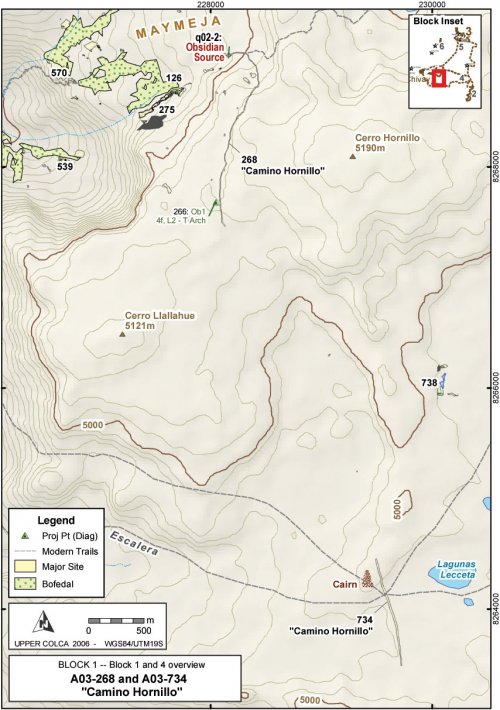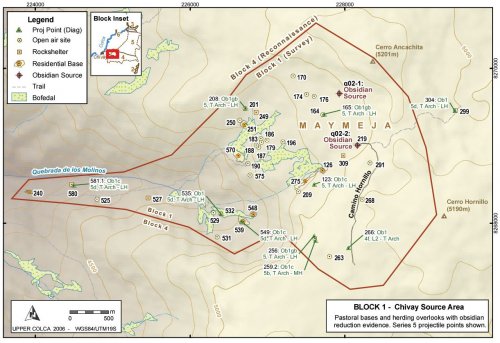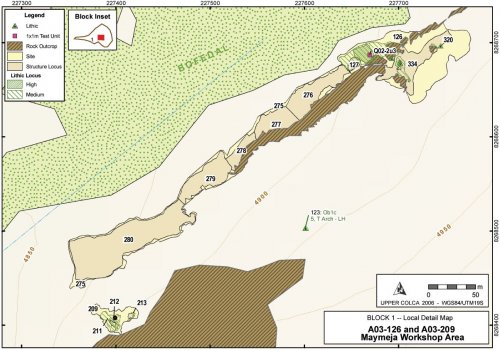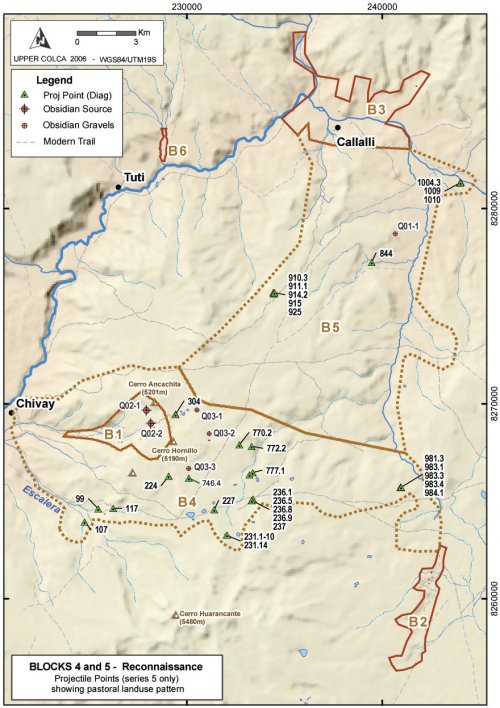6.4.1. Block 1 - Source
The Early Agropastoralist period in the Maymeja area of the Chivay source appears to reflect to major foci of economic interest in the area: (1) obsidian intensification, and (2) the exploitation of the rich pasture from the bofedal that lies in the western half of Maymeja. The strongest manifestation of settlement redundancy in the Maymeja area was at a handful of residential bases that were utilized by pastoralists over the millennia.
The most telling patterns in lithic production evidence come from contexts that differ from the expectations derived from purely pastoralist settlement patterns. For example, there is evidence of substantial settlement in an area with an obsidian workshop that is relatively unused today by the herder that dwells in Maymeja with over 200 head of alpaca. One explanation for this pattern is that the earlier settlement pattern was the result of obsidian procurement and production occurring at the quarry pit on the south side of Maymeja. That is, pastoral land use patterns are largely redundant in the region since approximately 3300 BC, but despite this redundancy there was variation from the purely pastoral pattern that suggests a Formative Period economic focus on obsidian production.
Block 1 Obsidian procurement features
One of the biggest challenges of working at the Chivay source during the 2003 season was evaluating the evidence for the incentives that drove ancient people to excavate a quarry pit to acquire larger nodules of obsidian, and the evidence for who was responsible for the quarrying work. Presumably, the earliest visitors to the Chivay source had the first pick of the largest and most homogeneous nodules, but over the millennia the source would be relatively depleted as compared with the initial abundance during early human visitation sometime in the Early Holocene. A quarry pit [Q02-2] that was encountered in the south-east quarter of Maymeja is evidence that investing labor in excavating for obsidian was indeed worthwhile.
At some sources, for example in the upper reaches of the Alca source as described by Rademaker (2005, pers. comm.) large blocks of obsidian of variable quality are found littering the surface. At lower elevations at the Alca source, and closer to large settlements, small cavities and tunnels were excavated to retrieve obsidian (Jennings and Glascock 2002).
Q02-2 "Quarry Pit"
The upper area of Maymeja, as well as the eastern flanks of Cerro Hornillo, are blanketed with small fragments of obsidian that appear as lag gravels among the tephra soils of the area (Section 4.5.1). In particular, flows and large nodules of obsidian are exposed through erosion in some areas, which suggests that underneath the tephra are larger nodules, but one has to excavate for them. On the north side of Maymeja, in an area heavily eroded by glaciers, a flow of obsidian [Q02-1] was observed but it contained vertical, subparallel fractures and was generally not suitable for tool production.
At the same altitude as this natural flow, but 700m to the south and across several moraines is a quarry pit [Q02-2] located in an area where the ashy soil was particularly light-colored. Similar open-air obsidian quarries have been described in central Mexico as "doughnut quarries" (Healan 1997) and "extracción a cielo abierto" (Darras 1999: 80-84). See Section 7.4.1 for further details on this quarry pit.
The coordinates of the Q2-2 pit are 71.5355° S, 15.6423° W (WGS84 datum), and it lies at 4972 masl. Around this quarry pit many small obsidian nodules in a depression were encountered that were typically < 5cm in size, but a few were closer to 15cm on a side. There is a smaller mound of sandy soil and small fragments of obsidian inside the larger quarry pit, suggesting that someone has attempted to further excavate the quarry pit in the more recent past.
Figure 6-45. Testing at Quarry Pit Q02-2 with 1x1 test unit Q02-2u3. Snow remains in the pit.
During the 2003 field season a test unit was placed in the debris pile immediately downslope of this quarry pit. The quarry pit and the test unit results are described in more detail in Section 7.4.1 and a brief discussion of ancient quarrying methods can be found in Section 8.3.2.
A03-268 "Camino Hornillo"
Departing from the quarry, a prehispanic road was identified that is 3-4m wide and is cleared of all but the largest rocks. This road [A03-268] departs the Maymeja area towards the south, following the route with the lowest gradient out of the volcanic depression, and avoiding difficult talus areas. As the road is defined by being swept free of rocks, the road is difficult to follow where it enters areas consisting only of sandy soil with no rocks to define its edges. In 2003 two sections of this road were mapped for a total of 3 km, and based on observations it can be described as of the " Cleared Road type: … systematically cleared of all stones or other debris" (Beck 1991: 75-76). While the soft pads of camelid feet negotiate rocky terrain with relative agility, loaded caravan animals generally travel on cleared roads and trails. Nielsen describes caravan routes in the open altiplano as "wide (4-10 m), straight, and free of vegetation, but lack[ing in] any improvement" (Nielsen 2000: 447). By these criteria, the route encountered at the Chivay source is relatively narrow, but it is roughly twice the width of a single-file path.
Figure 6-46. A03-269 and A03-734 "Camino Hornillo" and modern trail system.
No ceramics or architectural features were found in association with this road, and the only temporally diagnostic artifact identified was an obsidian type 4f projectile point diagnostic to the latter part of the Late Archaic and the Terminal Archaic. The construction of the swept road is being interpreted here as Terminal Archaic - Early Formative in age because it is associated with a workshop that contained radiocarbon dating to that time, and this date is further supported by the presence of the Terminal Archaic projectile point along the route.
At 4 km from the quarry pit, the southern segment [A03-768] of Camino Hornillo meets the Escalera route, a large trail that appears to have been a major thoroughfare for pack trains climbing steeply out of the Colca Valley to the puna and off towards the East-South-East (the direction of Lake Titicaca). A relatively large cairn or apachetastands on top of a boulder just northwest of this significant intersection, probably a guidepost marker in an otherwise open and featureless expanse.
|
Figure 6-47. Apacheta (cairn) close to junction of the Escalera route with Cerro Hornillo. |
While there were no artifacts associated with this cairn to facilitate dating its construction, the practice of contributing stones to cairns by passersby suggests that large cairn have some antiquity (Nielsen 2000: 447-448, 489). These features are associated with ritual activity in a variety of cultures worldwide including the North African Twareg (Rennell 1966 [1926]: 293), Tibetans (Trinkler 1931: 72), and other Himalayan highland groups (Valli and Summers 1994: 11). While cairns are abundant on an adjacent pass at Patapampa along the principal Arequipa highway to the Colca, those cairns have become a focus for tourist activity and many are the result of modern construction by passing tourists.
Today, the route of the modern Chivay - Arequipa highway has shifted traffic to Patapampa and around south side of Cerro Huarancante, and as a consequence these more ancient travel routes long used by pack animals, see little modern use except by local herders.
Interestingly, Camino Hornillo crosses the Escalera route and continues with the same width and definition in the direction of Nevado Huarancante to the south, as if the role of Camino Hornillo was more than simply a spur on the larger trail network in the direction of the Chivay obsidian source. Beyond the Lecceta-Escalera pass area, the Camino Hornillo [A03-734] begins climbing a hill and disappears again into sandy soil. Due to time constraints the 2003 field season team was not able continue following this road, but the route suggests that there was an objective in the southerly direction beyond the Escalera thoroughfare.
Figure 6-48. Camino Hornillo showing (a) A03-268 and (b) A03-734 segments. Photos were digitally modified to highlight the route in red.
The Quebrada Escalera route (in the southwest portion of Figure 6-46), which is now primarily a narrow footpath, seems to have had varying degrees of historical importance as access route in and out of the Colca. As reviewed in Section 3.2, the ethnographic accounts of caravans arriving into the Colca from the eastern puna are numerous (Browman 1990: 404,416-414;Casaverde Rojas 1977;Flores Ochoa 1968: 107-137). These caravans, by necessity, would have had to take one of the relatively steep routes that go to the north or the south of Nevado Huarancante. The route to the south of the mountain, which is the route taken by the modern highway to Arequipa (constructed in 1947 by Conscripcíon Vial), has steep pitches that would have presented obstacles to caravan transport as does the Quebrada Escalera route. Guillet (1992: 27-28) describes the historical importance of the construction of railroad station at Sumbay in Pampa de Cañagua, because with the railroad travel to the city of Arequipa by mule was reduced from being a one week journey to being a 2.5 day trip. One well-established route between Sumbay and Chivay passed through the Lecceta-Escalera area as it skirted north of Nevado Huarancante and descended Quebrada Escalera into the Colca. In sum, two faint segments are apparent of a road referred to here as "Camino Hornillo" that depart the quarry pit [q02-2] towards the south and arrive at the major travel route represented by the Escalera, but then the route continues southward in the direction of Huarancante. Further study of this road is needed.
Block 1 Reduction and projectile points in the Early Agropastoral period
Consumption patterns in the south central Andes indicate that projectile points are the most frequent artifact type for obsidian, a pattern that becomes particularly strong with Series 5 projectile point production sometime after the onset of the Terminal Archaic circa 3300 BCE An important question in this research is, therefore, "in what form was obsidian leaving the Maymeja zone during a particular time period?"
Part of this question is answered simply by looking at the 2003 projectile point inventory: obsidian Series 5 points are actually relatively scarce in the Maymeja area, and flakes that approach Series 5 projectiles in shape, are not especially common in the collections either (see Table 6-15, above). As will be suggested by the Maymeja excavation data in Section 7.4, distinct groupings of cores and flakes discarded at the workshop suggest that reduction was following a few discrete pathways that might indicate that two trajectories, both the flake-as-core and the flake directly to implement, reduction strategies were occurring at the Chivay source.
Block 1 Early Agropastoralist Settlement pattern
A primary goal of modern pastoralists residing in Maymeja is to guard their flock both during daytime grazing and during the night when rustlers, foxes, and, formerly, mountain lions, are liable to attack the herd (T. Valdivia 2003, pers. comm.). It is evident from regional distributions in the Chivay Source area that during the Terminal Archaic and Formative Period there was a combined interest in herd maintenance with obsidian production. A key feature of the Maymeja area is that procuring obsidian from this zone did not require compromising grazing potential for access to obsidian: both appear to have been available on the southern margins of Maymeja.
Figure 6-49. Block 1 possible Early Agropastoral settlement pattern with Series 5 projectile points.
Residential bases: Several large sites were identified that have been interpreted as residential bases for herders. These residential bases include corrals, possible remnants of residential structures, and site maintenance activity such as the discard of lithics in discrete areas. These bases represent probable overnight camps.
Open air sites: Small sites, consisting typically of a windbreak and a small obsidian scatter overlooking a bofedal, are distributed throughout the Maymeja zone. These small camps, described here as "open air sites" are probable day-use overlooks for herders.
Rock shelters: A number of small rock shelter sites were also encountered in this area. These are typically very small rock shelters, often no more than a small overhang of a boulder or the edge of a lava flow. The shelters commonly contain a small scatter of obsidian flakes, and sometimes cores, at the dripline of the rock shelter.
Miscellaneous other site types: Other kinds of sites include an obsidian quarry pit [q02-2], and Camino Hornillo [a03-268] which is a route leading to the quarry pit from the south.
A03-126 "Maymeja 1"
On the southern edge of Maymeja a site was located that contained a dense mound of flaked obsidian, an extensive scatter of obsidian, traces of terracing and wall building, but virtually no ceramics. Dates from a 1x1m test unit [Q02-2u3] placed in the obsidian mound (Section 7.4.2) showed that this site was occupied from at least the Terminal Archaic until the end of the Early Formative.
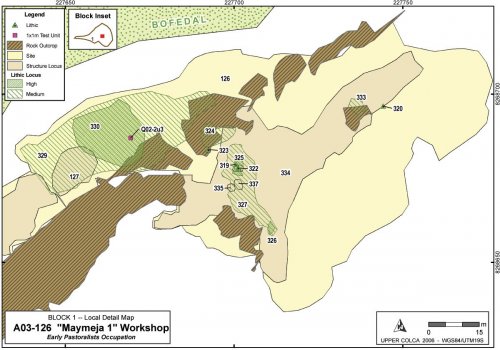
Figure 6-50. A03-126 "Maymeja 1" workshop and vicinity.
Maymeja 1 [A03-126] belongs to a complex of features that have been divided into an upper site A03-126, and a lower site A03-275 that has some LIP and LH component. This complex is located on the dry southern margins of the Maymeja area where viscous lavas emanating from the Cerro Hornillo vent slope downwards to the northwest into the depression referred to as Maymeja. Subsequent glaciation polished these lavas into smooth banks with excavated depressions that offer adequate shelter in this exposed region. The shelter and abundant sun in this north-facing zone is compensated for by the mountain winds that blow with regularity in the area.
Figure 6-51. View of A03-126 "Maymeja" from north. Terraced area A03-334 on upper level. Test Unit Q02-02 is just right of the orange bucket. Project tents are visible in corral A03-127.
|
(a) |
Figure 6-52. (a) Workshop area of "Maymeja 1" showing proximity of bofedal, (b) Testing Q02-2U3, with the quarry pit [Q02-2] visible among light ash 600m uphill in the background.
The residential base of A03-126 consists of two principal zones that show human modification: (1) the upper area above the polished lava bluffs visible in Figure 6-51, and (2) a lower zone that abuts the bofedal to the north. As the area is almost devoid of ceramics the primary indicators of occupation are lithic scatters of varying density and with highly eroded walls and terraces. The central greatest concentration of flaked stone is the workshop area labeled as a high density lithic locus [A03-330], shown on Figure 6-50.
|
Arch_ID |
Site_ID |
Feature Type |
Description1 |
Description2 |
Area_m2 |
|
126 |
126 |
Site |
"Mayemeja 1" |
Workshop and upper sector |
6,007.0 |
|
127 |
126 |
Structure Locus |
Walls |
Corral area |
130.6 |
|
275 |
275 |
Site |
"Mayemeja 5" |
Lower slopes parallel to bofedal |
10,401.4 |
|
276 |
275 |
Structure Locus |
Wall bases only |
Eroded terraces along lower slope |
1,414.2 |
|
277 |
275 |
Structure Locus |
Wall bases only |
Eroded terraces along lower slope |
978.2 |
|
278 |
275 |
Structure Locus |
Wall bases only |
Eroded terraces along lower slope |
524.6 |
|
279 |
275 |
Structure Locus |
Wall bases only |
Eroded terraces along lower slope |
1,234.2 |
|
280 |
275 |
Structure Locus |
Wall bases only |
Eroded terraces along lower slope |
4,306.6 |
|
324 |
126 |
Lithic Locus |
Medium Density |
Concentration in on top of lava outcrop |
49.6 |
|
325 |
126 |
Lithic Locus |
High Density |
Flakes washing down from structures |
12.4 |
|
326 |
126 |
Lithic Locus |
High Density |
Concentration in sheltered area |
4.5 |
|
327 |
126 |
Lithic Locus |
Medium Density |
Expanse of flaked stone |
182.4 |
|
328 |
126 |
Lithic Locus |
Low Density |
Light scatter coterminous with site bndy |
2,942.7 |
|
329 |
126 |
Lithic Locus |
Medium Density |
Expanse of flaked stone |
940.5 |
|
330 |
126 |
Lithic Locus |
High Density |
Workshop mound |
292.1 |
|
333 |
126 |
Lithic Locus |
Medium Density |
Concentration in sheltered area |
15.6 |
|
334 |
126 |
Structure Locus |
Wall bases only |
Eroded terraces along lower slope |
1,504.4 |
|
335 |
126 |
Structure Locus |
Wall bases only |
Base of circular structure |
4.3 |
|
336 |
126 |
Structure Locus |
Wall bases only |
Base of circular structure |
5.2 |
|
337 |
126 |
Structure Locus |
Wall bases only |
Base of circular structure |
5.5 |
Table 6-48. Areal features belonging to A03-126 and A03-275 workshop complex.
Spatial features in this area were initially delimited with dGPS and then, during a visit in 2004, the boundaries of the smaller structural features were remapped with a total station.
Terraces and structure bases
At an altitude of nearly 5000 masl in sandy soil, this area is far above the growing zone even for tubers. If these were residential terraces, where were the ceramics? One possible explanation was provided from three14C samples from the workshop test unit [Q02-2u3] that revealed that the workshop occupation belonged to the preceramic and very early ceramic period. It appears that that the dominant component of this site is from prior to the use of ceramics in the area.
The terrace margins are generally highly eroded and ill-defined in places, and the focus in 2003 was therefore on mapping terraced zones as several large polygon areas rather than attempting to map each terrace as a linear feature. The upper terraced area [A03-334] was particularly eroded, but faint traces of intermittent terraces were apparent. The terraces walls, and wall bases that appear to have been small circular structures, are single walled with no mortar. The sole exception was a corner of doubled-walled construction made of ground fieldstone in the lower terraced area [A03-276] where the corner of a structure of cut-stone masonry of possible Late Horizon date was located, a feature that is described later in the Late Prehispanic Block 1 section.
The eroded terraces of A03-275 are generally 20-50cm in height and are constructed with fieldstones of a variety of sizes. Typically, a few large boulders will form the general structure of the terraces, and then small level surfaces would be constructed by building terrace walls of the flat local lava rock. It is difficult to date these constructions but due to the presence of sherds from several Inka plates, and a possible LH feature, these terraces are further discussed in the Late Prehispanic section titled A03-275 "Maymeja 5", along with several photos of these constructions.
In the sector of A03-126, above the bofedal margin, several small circular structures [A03-335] of possible Early Agropastoralist age were identified. These structures consist of circular wall-bases with concentrations of obsidian eroding downslope from the interior area. Two adjacent circular constructions were in the middle of an eroded terrace, but the predominant pattern was for small circular constructions measuring 2-3m in diameter to be built adjacent to rock outcrops that appear to offer protection from the western winds. These small wall-bases were observed along the expansive rock outcrop that extends just south of the bofedal. No hearths or bones were observed in this area, although bone preservation would probably be very poor in this exposed area.
Figure 6-53. Base of structure [A03-335] is formed by fifteen large, partially buried stones and measures 2.5m in diameter.
These structures are being interpreted as residential constructions or windbreaks occupied on short term basis by obsidian procurers who were allowing their animals to graze while they quarried and reduced obsidian from the Maymeja area, and perhaps dug the quarry pit Q02-2. Herders would presumably have had sufficient animal hides and woolen textiles to insulate stone walled structures from the penetrating winds.
It is also conceivable that these are bases for large circular LIP chulpas, as the wall bases are sufficiently large. This is unlikely, however, as there were no LIP ceramics in the area, and the obsidian flaking debris eroding downhill strongly suggests that obsidian reduction was occurring inside these circular structures.
Workshop mound
The workshop mound [A03-330] forms the largest and highest density of flaked obsidian observed in the Upper Colca project region. The 1x1m test excavation in this mound (Section 7.4.2) revealed episodes of reduction activity that generated cultural levels with distinctive concentrations of knapping debris associated with early stage reduction. The flake densities attenuate away from the mound center where the test unit was placed, and immediately south-west of the mound a corral is evident that is probably relatively ancient. One possibility is that animals were loaded with obsidian inside the corral subsequent to knapping at the workshop.
A03-209 "Maymeja 7"
Approximately 700m to the south-west of the workshop area another concentration of culturally derived obsidian flakes was encountered, and this concentration was distinct in that it was well-removed from the area with naturally abundant obsidian. A small cavity in a rock face was located with what appeared to be a wall in back and a large obsidian scatter extended down the hill below the wall cavity. The rock cavity may have contained a burial at some point, but the space was empty save for a few LIP sherds. This reduction zone was notably distant from the obsidian source, away from the bofedal, and was uphill and on a relatively steep slope (25º) high above any of the eroded terracing. Given the density of this reduction area, including two high density loci measuring 17m2and 39m2, the best explanation appears to be that this site conforms to the previously observed pattern of obsidian reduction occurring on the western lip of the Maymeja area where the views westward are excellent (see interpretation in Section 8.3.3 ). The mean visibility value for features in Block 1 overall is 18.5, while the visibility value for A03-209 is 31, or 40% higher than the average visibility in Block 1.
Figure 6-54. A03-126, 209, 275 Maymeja workshop and vicinity.
A03-201 "Saylluta 2"
This site consists primarily of a medium sized corral built among large colluvial boulders that have descended from the north margins of the Maymeja area. The area is littered with obsidian flakes, and natural and culturally fractured obsidian flakes cover the ground. It is perhaps due to the extensive glaciation in the area that the sandy soils of this corral contain a low density of geologically fractured obsidian flakes.
Figure 6-55. View looking south from above at A03-201 "Saylluta" with excavation of test unit Q02-2u1 under way in top center of corral by the orange bucket. Site datum is on top of the large boulder to the south of Q02-2u1 (just above test unit in the photo).
The corral offers excellent protection from the mountain winds that prevail on the southern edge of the Maymeja area, but at the cost of warmth from direct sunlight. In early August the sun would disappear from this area around 4pm. As is visible in Figure 6-55, a wall between 1.5m and 2m in height encircles this corral, and constructed stairs access the corral from the south. A fan of flaked obsidian, bone fragments, and a few unslipped, unpainted pottery fragments extends 20m downslope from the access stairs to the edge of a grassy area that has probably been a bofedal during wetter times.
A test unit [Q02-2u1] was placed on the southern half of this corral, and it revealed a fill of sandy local soil, and perhaps camelid dung, that was used to level out this corral in an otherwise sloping area. A discouraging colonial-style nail was encountered in level 4 of this test unit, suggesting a post-conquest occupation, nevertheless the test unit was excavated to sterile where large, irregular rocks cover the base of the 1x1. No distinctive prehispanic features were identified, and as yet the small pieces of carbon recovered from this test unit have not been analyzed with14C dating.
This corral is a suitable shelter from wind and it is also relatively well hidden and could serve as a refuge as it goes unnoticed among the talus boulders of northern Maymeja. Due to the lack of sunlight during the winter months, and the relative scarcity of water adjacent to A03-201 under current conditions, this location is thermally a less comfortable camp as compared with the sites on the southern edge of Maymeja.
A03-570 "Valdivia 1"
At the lower end of Maymeja, close to where the principal trail arrives in the zone from Chivay, a large obsidian scatter was encountered adjacent to an active estancia owned by Eliseo Vilcahuaman Panibra but occupied by Timoteo Valdivia who was hired to guard the herd. The site of A03-570, defined by a low density scatter of obsidian flakes, occupied the entire east slope of a large breccia promontory that forms one of the distinctive landmarks on the western edge of Maymeja. A relatively large (419m2), medium density scatter [A03-572] is located on the northern end of this area, where the water from the northern half of Maymeja cascades over the breccia layer and descends steeply into Quebrada de los Molinos.
The site of "Valdivia 1" [A03-570] appears to be a prime site for occupation by pastoralists. The excellent views of two of the largest bofedales in the Maymeja area, extensive sun throughout the day, and a position on the lee side of a promontory protecting it from the westerly winds make this place a desirable location for pastoralists in the area. This site, and the adjacent site of A03-190 at the head of the trail from Chivay, belong to a cluster of sites that occupy the steep western margin of the Maymeja area and that provide sweeping views of the Quebrada de los Molinos. This site has a high visibility index, particularly from the lithic locus A03-571, where a visibility index value of 40.6 was calculated that can be compared with a mean visibility index of 18.5 for sites in Block 1. An interpretation of these viewshed values is discussed in Section 8.3.3.
A03-539 "Mamacocha 5" and A03-548 - "Mamacocha 6"
These pastoral bases in the upper end of Quebrada de los Molinos have been considered bases because of the remnants of large corrals found in therein. However, these sites lack temporally diagnostic materials. This area consists of moraines with large lava boulders that have descended from the steep slopes above and offer wind protection as well as a few small rock shelter features.
Blocks 4 and 5 Reconnaissance Areas
The diffused nature of pastoral settlement was evident from the distribution of land use observed in the extensive Blocks 4 and 5 zones. These areas primarily consist of rugged lava terrain that appear desolate in the dry season. In the wet season, however, there are probably adequate grazing opportunities through these areas. By distributing pastoral impacts over the larger landscape during the wet season, the bofedales would be allowed to recover.
Figure 6-56. Blocks 4 and 5 showing Series 5 projectile point distribution.
Series 5 projectile points are not exclusive to the Early Agropastoral period, but given the increase in obsidian production during that period, this dataset provides a perspective on this period that is not available for this transitional stage between diagnostic lithic and ceramic technologies. One informative aspect of the Blocks 4 and 5 projectile point distributions is from the types of obsidian in use for projectile point manufacture. Recall that much of the obsidian surface gravels available at around 4975 masl on the eastern flakes of Cerro Hornillo contain deficiencies either because they contain heterogeneities or because they derive from smaller nodules. Projectile points from Blocks 4 and 5 are almost never made from material with heterogeneities.
|
Proj Points |
Ob1 |
Ob2 |
Volcanics |
Total |
|
5 |
25 |
1 |
1 |
27 |
|
5a |
2 |
2 |
||
|
5b |
2 |
2 |
||
|
5d |
9 |
9 |
||
|
Total |
38 |
1 |
1 |
40 |
Table 6-49. Material types for Series 5 points in Blocks 4 and 5.
This table demonstrates that despite the proximity of many of these sites to Ob2 surface obsidian gravels with heterogeneities, the Ob2 material was almost never used for point production. The obsidian observed on the eastern flanks of Hornillo did not entirely consist of Ob2 material with heterogeneities. In fact, the Q03-3 source south of Hornillo contained nodules measuring 15 cm across free visible heterogeneities. The Q03-3 material, however, did not appear as transparent as the Q02-2 glass from Maymeja.
Discussion
During the Early Agropastoralist period in the obsidian source area observed what appears to be intensive obsidian production in the initial stages of reduction at a workshop 600m downslope from the quarry pit, as well as evidence that suggests that obsidian was being transported away from the Maymeja area as whole nodules.

